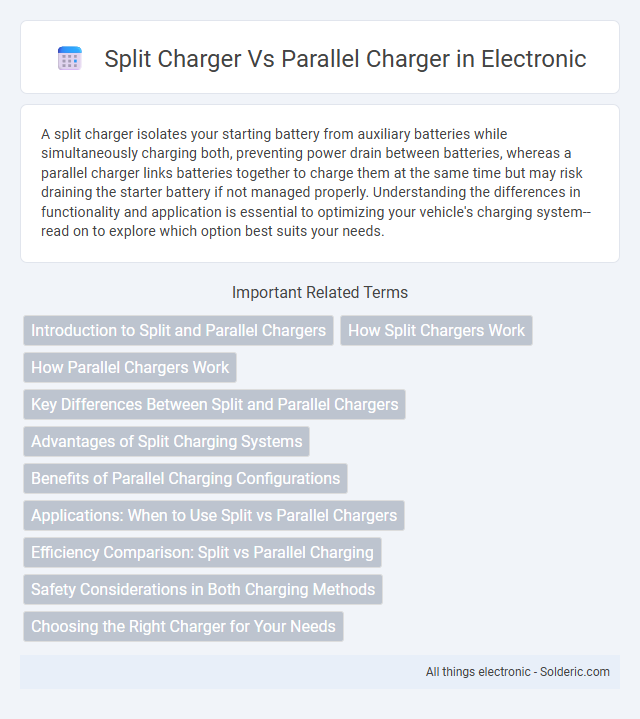A split charger isolates your starting battery from auxiliary batteries while simultaneously charging both, preventing power drain between batteries, whereas a parallel charger links batteries together to charge them at the same time but may risk draining the starter battery if not managed properly. Understanding the differences in functionality and application is essential to optimizing your vehicle's charging system--read on to explore which option best suits your needs.
Comparison Table
| Feature | Split Charger | Parallel Charger |
|---|---|---|
| Function | Distributes alternator output to multiple batteries separately | Connects multiple batteries in parallel for combined charging |
| Charging Control | Manages charging independently for each battery bank | All batteries receive identical charging current simultaneously |
| Battery Isolation | Keeps batteries isolated to prevent discharge between banks | Batteries are linked, sharing charge and load equally |
| Use Case | Ideal for dual battery systems requiring isolated charging | Best for combining similar batteries to increase capacity |
| Complexity | More complex wiring and charger system | Simpler setup with straightforward parallel connections |
| Cost | Typically higher cost due to specialized equipment | Lower cost, uses basic cables and connectors |
| Battery Life Impact | Prolongs battery life by preventing cross-drain and overcharging | Battery life depends on balanced battery health and matching |
Introduction to Split and Parallel Chargers
Split chargers and parallel chargers serve distinct purposes in electrical systems for efficient battery management. Split chargers distribute charging current between multiple batteries from a single source, preventing overcharging and ensuring balanced power delivery. Parallel chargers, on the other hand, connect multiple batteries directly to increase overall capacity while maintaining the same voltage level, ideal for applications requiring extended runtime.
How Split Chargers Work
Split chargers manage battery charging by directing power from a single alternator to multiple batteries without isolators, ensuring each battery receives an appropriate charge simultaneously. By automatically splitting the current, they prevent battery drainage by isolating batteries once the engine is off, protecting your starting battery from being depleted by auxiliary loads. This efficient charging method is ideal for dual battery systems in vehicles and marine applications.
How Parallel Chargers Work
Parallel chargers function by connecting multiple batteries directly to a single charger, allowing them to charge simultaneously while maintaining the same voltage across each battery. This method ensures even distribution of charging current, preventing overcharging and balancing the overall charge level. Your batteries receive efficient power input, maximizing charging speed and extending battery lifespan during the process.
Key Differences Between Split and Parallel Chargers
Split chargers direct alternator current to multiple battery banks sequentially, preventing overcharging and ensuring each battery receives optimal voltage independently. Parallel chargers connect all batteries simultaneously, allowing them to charge together but risking uneven charging and potential battery damage if the banks have different capacities or states of charge. The key distinction lies in split chargers offering controlled, isolated charging for varied battery types, while parallel chargers provide a simpler, but less precise, unified charging approach.
Advantages of Split Charging Systems
Split charging systems offer the advantage of charging multiple batteries independently, ensuring that your starter battery remains fully charged without draining the auxiliary battery. This system enhances reliability and battery lifespan by preventing over-discharge and enabling simultaneous charging from a single source. By prioritizing the starter battery, split chargers improve the overall electrical system efficiency in vehicles and marine applications.
Benefits of Parallel Charging Configurations
Parallel charging configurations enable simultaneous charging of multiple batteries, significantly reducing total charging time and improving efficiency. This setup balances current distribution evenly across all cells, enhancing battery life and maintaining optimal voltage levels. Parallel charging also simplifies the process by using a single charger for multiple battery packs, reducing the need for multiple chargers and minimizing equipment costs.
Applications: When to Use Split vs Parallel Chargers
Split chargers are ideal for applications where you need to charge two separate battery banks independently, such as in RVs or boats with dedicated starter and house batteries to prevent one battery from draining the other. Parallel chargers work best when you want to charge multiple batteries simultaneously from a single source, commonly used in off-grid solar systems or upgraded vehicle electrical setups to boost capacity. Your choice depends on whether your priority is isolating battery circuits or maximizing overall charging efficiency.
Efficiency Comparison: Split vs Parallel Charging
Split chargers deliver power sequentially to multiple batteries, often resulting in higher efficiency by reducing voltage drops and minimizing energy loss during charging. Parallel chargers charge all batteries simultaneously by connecting them directly, which can cause uneven charging and increased heat generation, lowering overall efficiency. Studies show split charging systems improve battery lifespan and energy utilization by optimizing current distribution compared to parallel setups.
Safety Considerations in Both Charging Methods
Split chargers incorporate built-in charge controllers that prevent overcharging and promote battery health by regulating current flow, enhancing safety during the charging process. Parallel chargers, while capable of faster charging by distributing current evenly across batteries, require careful matching of battery types and capacities to avoid imbalances that could lead to overheating or damage. Implementing proper fusing, temperature sensors, and monitored charge cycles are crucial safety measures for both systems to minimize risks and ensure reliable battery maintenance.
Choosing the Right Charger for Your Needs
Selecting the right charger depends on your device requirements and charging priorities; a split charger allocates power separately to multiple batteries, ensuring targeted charging and preventing overcharge, while a parallel charger combines battery banks to deliver a higher overall current for faster charging of identical batteries. Your choice should consider battery compatibility, charging speed, and safety features to optimize performance and longevity. Understanding these differences helps you maximize efficiency and maintain your batteries in optimal condition.
Split charger vs Parallel charger Infographic

 solderic.com
solderic.com